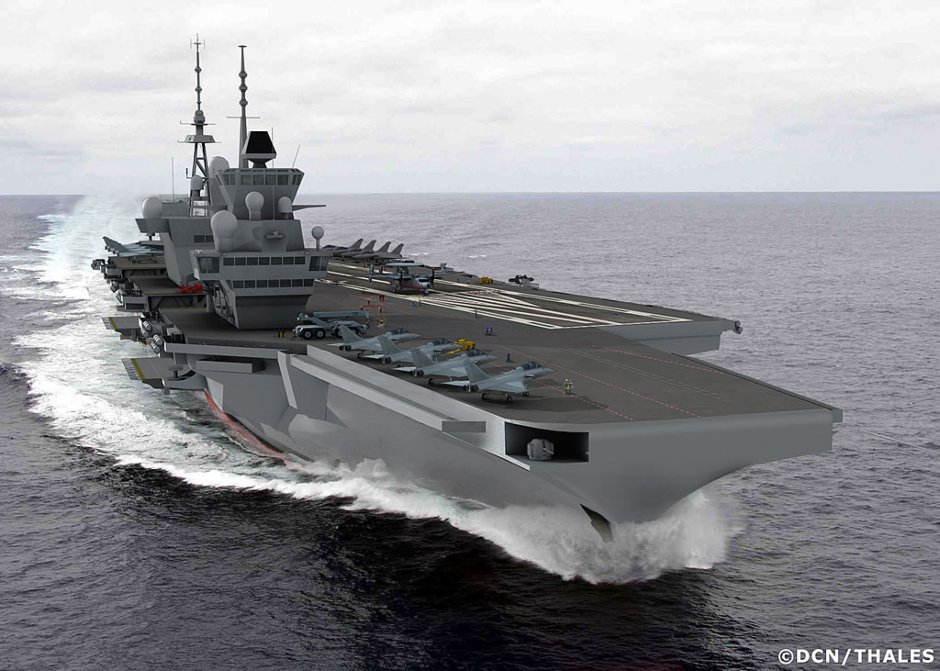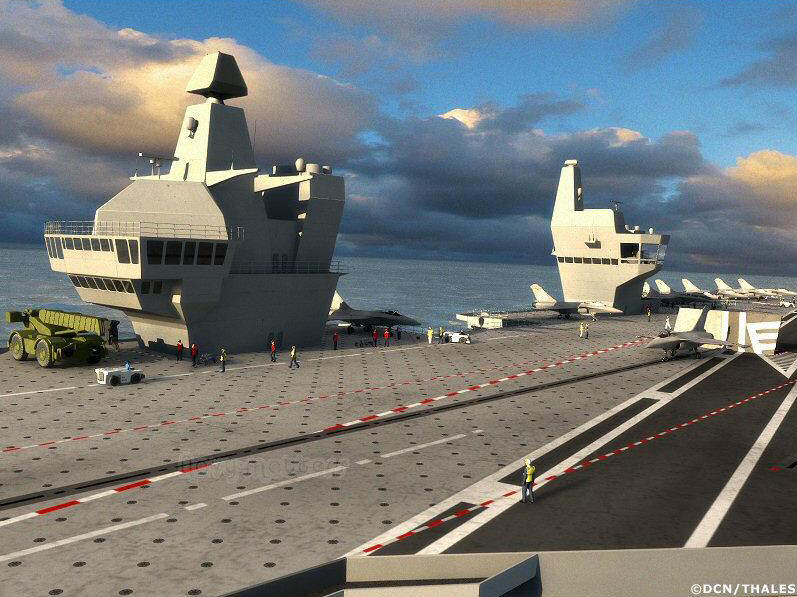세계 항공모함 시리즈(5)
Richelieu
PA2 (Deuxieme Porte Avions)
프랑스 해군 차세대 항공모함
[클릭원본]
프랑스 해군이 2009년부터 건조에 들어갈 예정에 있는 Foch의 후계 차세대 항공모함인 PA2 (Deuxieme Porte Avions) 입니다.
당초에는 프랑스 해군이 Charles de Gaulle 2번함을 도입할 계획에 있었지만, 초도함의 건조계획에서부터 문제를 많이 일으킨 것을 잘 아는 프랑스 의회에서 추가 건조비용을 좀처럼 승인하지 않았고, 취역 이후에도 계속 제기되는 Charles de Gaulle의 문제점으로 인해 프랑스 해군 수뇌부에서조차도 신뢰성을 잃어 재래식 추진의 신형항모를 구상하게 되었습니다.
초기에는 DCN이 제안한 독자적인 신형 디자인의 만재 55,000t 급 항공모함의 설계안이 제안되었으나, 예산절감 이외에 영국 해군의 CVF계획 진행상황의 영향(계획 출발당시 40,000t급이었으나 현재 65,000t)을 받아 더 대형의 항공모함 도입필요가 제기되어 영국의 차세대 항공모함인 Queen Elizabeth(CVF)급 항공모함의 설계안을 전용, 변경하여 건조하기로 결정된 상태입니다(Thales사의 설계안을 DCN과 절충한 형태).
탑재될 함재기는 Rafale M인 만큼 캐터펄트 이착륙 방식을 사용하며, Chales de Gaulle 항모 건조사업 때 짧은 함의 길이로 인해 혼쭐이 난 만큼 영국해군의 Queen Elizabeth(CVF)급보다 (아주)약간 더 긴 넉넉한 길이 및 선체크기를 보유합니다.
2007년에 정식으로 주문되어 2009년에 건조에 들어갈 예정이며, 2011년 진수, 2015년 정식취역을 목표로 사업을 진행할 예정에 있습니다.
제원
전장 : 284m
전폭 : 73m
흘수 : 11.5m
만재배수량 : 66,000 - 75,000t?
추진기관 : RR MT-30 가스터빈 2기, 디젤 4기, 2축추진, 항속거리 15kt시 10,000nm
속력 : 25kt
무장 : Sylver VLS 16 cell (Aster 15 단거리 함대공미사일 16기), Giat 20F2 20mm 기관포 4문
탑재기 : 평시 Rafale M 32기, E-2C 3기, NH-90 5기
승조원 : 1,000명, 항공요원 650명
예정함명(추정) : Richelieu (R92?)
****************************************
Future Aircraft Carrier (CVF)
[Porte-Avions 2]
|
Ordered: |
2012 (projected) |
|
Laid down: |
2012 (projected) |
|
Launched: |
2015 (projected) |
|
Commissioned: |
2017 (projected) |
|
Fate: |
Advanced level design |
|
General characteristics | |
|
Type: |
Unique aircraft carrier |
|
Displacement: |
est. 70,000-75,000 tons full load |
|
Length: |
283 m overall |
|
Beam: |
73 m overall |
|
Draft: |
11.5 m |
|
Propulsion: |
Two RR MT-30 Gas turbine |
|
Speed: |
26 knots (48 km/h) |
|
Range: |
10,000 nautical miles at 15 knots |
|
Complement: |
Ship's Company: 1,000 |
|
Sensors and |
Héracles air search and target acquisition radar |
|
Armament: |
two 8 cell SYLVER launchers carrying the MBDA Aster 15 surface to air missile. Giat 20F2 20 mm cannons. |
|
Aircraft carried: |
48 aircraft, including: |
la France sans porte-avions
(Above) Bidders were required to develop both Short Take-Off Vertical Landing (STOVL) and Conventional Take Off and Landing (CTOL) CVF concepts- these images of the Thales/BMT design concept were released in June 2002
In September 2002 the MOD said that the new carriers would be completed in a STOVL configuration, but should be "adaptable" to CTOL configuration if required later - with catapults and arresting gear replacing the bow 'ski-jump'.
(Thales CVF Team)
(Below) This graphic of the 'Alpha' CVF first appeared in March 2003. Although the design concept developed by consortium lead by the Thales had been selected, the MOD ordered them to form an alliance with the BAE Systems for the construction of the ships.
Cost estimates in the Spring of 2003 were far in excesses of the available budget, leading to intense cost reduction efforts and a multi-year delay to the project
(Thales France)
7seas
7seas-1
(Above) This small scale (perhaps 1:300) but still very interesting model of CVF was displayed on the Thales stand at Euronaval in October 2004. It was the first public showing of the reduced cost "Delta" design and significant differences can be observed compared with the "Alpha" graphics released in the first half of 2003 (more shown on this page here). The most notable changes are the prominent raked funnels on each island, the apparently reduced electronics fit (although some antennae will be hidden inside the new new stealth technology masts), the shortened hull length ahead and aft of the forward island, the reduced flightdeck width (and thus hull sponsons) aft, and the split bow ski-jump with deck parking to starboard.
(Above) These graphics of the CVF "Delta" concept were issued in October 2004, the first for 17 months. Compared with the earlier "Alpha design, hull length has been cut from the bow section and immediately aft of the forward island.
Major changes to the flight deck layout are obvious, as is the potential for fitting an angled landing lane in the future. Note that the side-by-side JSF launch positions have been deleted, there is now just a single JBD alongside the aft "FLYCO" island. The MT30 gas turbine alternators are mounted in the massive sponsons directly below each island.
The aft island had been greatly simplified and both islands incorporate obvious stealth or signature reduction features. What appears to be an Alenia Marconi Systems S1850M long range radar is atop the forward island, but no Sampson multifunction radar is fitted.
Self defence systems are relatively light, although a Vulcan Phalanx system and a DS-30B light cannon can be seen in small sponsons on the port and starboard forward quarters.
(Above) These pictures of the CVF CTOL (or CV) variant did not appear until early 2006, but are probably contemporary with the STOVL variant above.
Contingency plans exist to complete the second CVF in a CTOL configuration if the Americans cancel the STOVL F-35B variant. The first will still be completed in a STOVL configuration to operate the Harrier until it leaves service. (Source: JSF Team)
(Above) These are two of several images that first publicly appeared in June 2005, I don't have a copy of the others. There are no obvious great differences from earlier graphics, presumably indicating that the design has now matured and stabilised.
(Above) Extracts from a DCN video showing French and British CVF carriers in company. (Source: Beedall)
(Above) A series of updated CVF graphics were published in December 2005 to support the announcements made that month. (Source: MOD)
(Above) This graphic was also used by the MOD in December 2005. Interestingly it shows a CTOL configured CVF. It appears to be an update of a graphic first used in 2003. (Source: MOD)
(Above) Profile of CVF Delta dating to 2006. Stated to be 280 metres long, 9 metres draft, air draft 47 metres, 9 decks. (Source: ACA)
(Above) The first new set of static graphics of CVF UK since 2005 were published in August 2007. The French influenced redesigned bow can be seen, some changes have also been made to the islands and the port side of the flight deck (presumably to improve standardisation with the French PA2). (Source: MOD)
(Above) For comparison purposes, an image of the French CVF variant that I received in early 2007. (Source: DCN)
(Above) These pictures also began to trickle out between August 2007 and the end of the year. The last picture shows a F-35B making a vertical landing but the design is now expected to support shipborne rolling vertical landings (Source: MOD)
(Above) These graphics also appeared at the end of 2007, further significant revisions have been made to the islands compared to the pictures above. A long range S1850M search radar is shown fitted atop the fore island, it is unclear whether this will actually be fitted in addition to the Artisan 3D medium range radar - rather incorrectly depicted on the aft island. (Source: MOD)
Short take-off and ship borne rolling vertical landings using the STOVL F-35B were favoured by 2008, however the CV F-35C with its requirement for catapult launches and arrested landings remains a fall back option if the F-35B encounters serious problems. This graphic from early 2008 shows a F-35C on final approach. (Source: Thales)
Introduction: The CVF Project
Maritime Afloat Replenishment and Support (MARS),
Sea based support for CS, without MARS supplying bombs, fuel and stores Carrier Strike loses any ability to be expeditionary.
[세계삼한역사연구:한부울]
'무기리스트 > 세계전투함정' 카테고리의 다른 글
| 프랑스 찰스드골호 Charles De Gaulle (0) | 2007.09.10 |
|---|---|
| 러시아 쿠즈네쵸프호 Admiral Kuznetsov (0) | 2007.09.10 |
| 미국 키티호크급 Kitty Hawk (0) | 2007.09.10 |
| 미국 엔터프라이즈급 Enterprise Class (0) | 2007.09.10 |
| 미국 니미츠급 Nimitz Class (0) | 2007.09.10 |







































